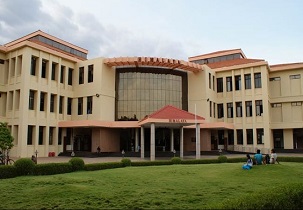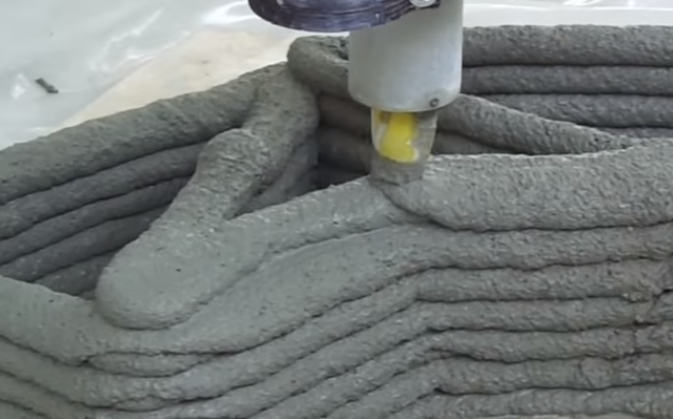India: IITM Makes Strides for Construction Industry & 3D Printing with Concrete; Expert Opinions Vary on Timeframe for True Impact
The Indian Institute of Technology at Madras (IITM) is planning to make their mark with 3D printing, literally, as they plan for transformation to the construction industry within India. While not everybody is completely impressed as to either the complete feasibility or realistic timing of this new technology, IITM seems to be on board for the most part, and that includes project heads for materials such as Koshy Varghese and Ravindra Gettu of their Department of Civil Engineering.
Showing how heavily invested they are becoming in the concept of 3D printing with concrete, a team from IITM will actually be presenting the idea to much of the Indian construction industry during a global meeting today. There, as representatives from all over the world, to include the US, China, Germany, and France, are in attendance, IITM will explain that indeed they do see 3D printing in concrete as part of construction industry’s future. They have also created a prototype of a 3D printer in the Department of Mechanical Engineering, demonstrating not only a keen interest in the technology but a commitment to their belief that such machines may be leading the way for building very soon.
Engineers at IITM surely are not the only ones thinking this way. There is great interest in concrete worldwide, with analysts also projecting that it will expand substantially in the next few years. Not just limited to construction, 3D printers are being used to create everything from industrial furniture to massive art installations, employing numerous printers as well as robots. While often those works are presented just to show the sheer power of concrete and 3D printing combined, in construction those innovating are seeking immediate functionality, such as the first 3D printed office building in Dubai.
Dubai, of course, has instituted an initiative in their city-state that is now serving as a role model globally. We’ve reported extensively on their plans to work 3D printing into substantial roles in the main sectors of medical, construction, and consumer products, with the office building serving as the just the beginning—and impressively—built in just seventeen days, with two more for assembly.
As the rest of the world creeps behind Dubai in the erection of 3D printed office buildings and formal initiatives, still it’s no secret that as 3D printing poured into the mainstream, optimism for the construction industry was rather immediate. A quick slowdown was exhibited, however, as it became apparent that for the most part the technology’s role was simply too cost-prohibitive in construction. There also were not a lot of materials and hardware to work with initially. Now, as corporations and even governments begin to back development, we’re seeing some major promise.
With the benefits of a 3D printer, once costs are under control, builders are able to work with stunning speed. Anyone who has ever been involved in a construction project is well aware of how much time can pass before something has actually been completed. Here, structures can be built in a fraction of the time, and if necessary, in modular designs for easy transportation—convenient for temporary housing situations and events of any size. Designs that simply were not feasible before can be made now with these processes as well.
IITM’s mechanical engineers have a created a 3D printer for industrial purposes that so far uses only polymers and metal as materials; however, plans are in the works for development of a concrete printer to begin shortly. Varghese and Gettu, of course, are both well versed in the use of concrete materials.
Many though are certainly not convinced that 3D printing in construction is coming along immediately.
“Members of Indian Concrete Institute (ICI), Ready Mixed Concrete Manufacturers Association (RMCMA), L&T and Ultratech will seek clarifications on the technology at the global meet and come out with a position (white) paper,” said Surendra P. Shah, honorary visiting professor at IITM and professor emeritus at Northwestern University in a recent interview.
It’s not unusual for thoughts on this technology, or change in general, to be mixed, and that’s certainly not limited to India. For the most part though, thoughts on the subject are positive.
“Imagine, you are designing, choosing material including walls, roofs, floor, pillars etc. for your house. In Germany, there is a mall which sells only the building material. All we have to do is bring them and attach on site. It will be automated. 3D printing will cut the time and should cut the cost when scaled up. However, it will take at least a decade for it to emerge as alternative,” said B. Sivarama Sarma, Head (R&D), L&T Construction.
Many of course are chomping at the bit to start making more complex constructions faster. Fewer hours in human labor need to be spent and more ecologically friendly materials and processes can be used—along with less waste. But 3D printing in construction will continue to take time in showing its benefits to world, as many continue to weigh the pros and cons and use of the technologies and materials required is promoted, encouraged, and used.
“Yes, it has potential. Precast concrete, for example, in the last three years has gained lot of attention,” said V. Ramachandra, Technical Head, UltraTech Cement Ltd. “But, in India, people see whether the technology has value for money. Even if 3D printing cuts down the time of construction and remains expensive, it will not taste success.”
As the time for the global meet drew closer, an international workshop was coordinated (held on Monday) and held at the Centre for Industrial Consultancy and Sponsored Research. Learning institutions and companies participating included: Hong Kong University of Science and Technology; Lafarge Holcim R&D, France; RAPIDS Construction Safety and Technology Laboratory, Stuttgart, Germany, and University of California at Berkeley, US. Participants attending from the Technical University Dresden, Germany, gave a presentation at the workshop in regards to their thoughts on how 3D printing in concrete is progressing, as well as discussing its benefits and current limitations. Discuss further over in the India 3D Printing forum at 3DPB.com.
[Source: The New Indian Express]Subscribe to Our Email Newsletter
Stay up-to-date on all the latest news from the 3D printing industry and receive information and offers from third party vendors.
You May Also Like
Nylon 3D Printed Parts Made More Functional with Coatings & Colors
Parts 3D printed from polyamide (PA, Nylon) 12 using powder bed fusion (PBF) are a mainstay in the additive manufacturing (AM) industry. While post-finishing processes have improved the porosity of...
3DPOD Episode 193: Flow and What’s Possible in 3D Printing with Ricky Wildman, University of Nottingham
Ricky Wildman is working on 3D printing pills, but, as Professor of Multiphase Flow and Physics at Nottingham, he does a whole lot more. His research encompasses the characterization of...
3D Printing Webinar and Event Roundup: March 17, 2024
It’s another busy week of webinars and events, including SALMED 2024 and AM Forum in Berlin. Stratasys continues its in-person training and is offering two webinars, ASTM is holding a...
3D Printed Micro Antenna is 15% Smaller and 6X Lighter
Horizon Microtechnologies has achieved success in creating a high-frequency D-Band horn antenna through micro 3D printing. However, this achievement did not rely solely on 3D printing; it involved a combination...

































